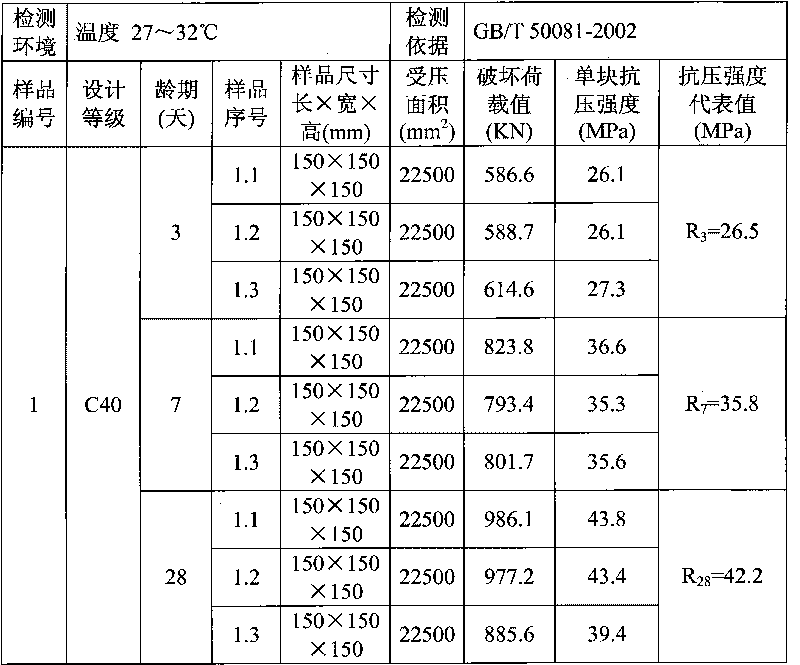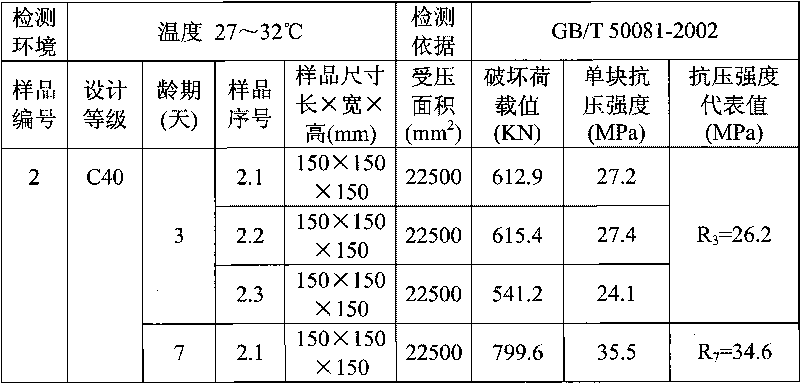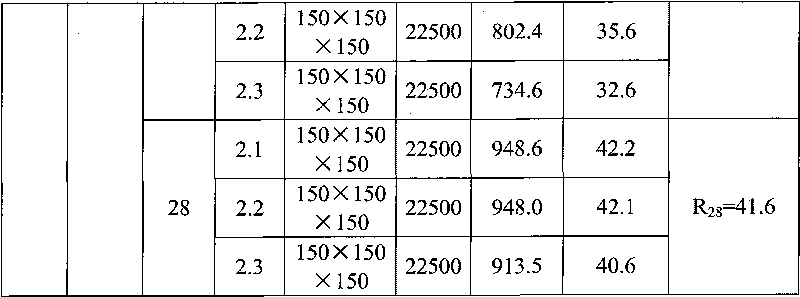Cement concrete
A technology of cement concrete and mass ratio, applied in the field of cement concrete for building construction, can solve the problems of low concrete strength, limited use site, small application range, etc.
- Summary
- Abstract
- Description
- Claims
- Application Information
AI Technical Summary
Problems solved by technology
Method used
Image
Examples
Embodiment 1
[0007] The following components are used for each cubic meter of cement concrete: 130kg of limestone, 50kg of yellow phosphorus slag, 5kg of cellulose ether, 12kg of defoamer, 148kg of superfine silica fume, 375kg of sand, 530kg of stone, 145kg of water, and 50kg of fly ash. Aminobenzenesulfonic acid 70kg, hydroquinone 60kg, sodium methyl silicate 15kg, steel slag 53, cementing material 140kg, sodium sulfate 7kg, calcium carbonate 20kg, calcium lignosulfonate 6kg, benzoquinone 3kg, alumina 70kg, sub Sodium nitrate 28kg, ferrous sulfate 30kg, polyethylene glycol octyl phenyl ether 10kg, rare earth powder 42kg, butadiene 16kg, hydroxyethyl acrylate 11kg, carbon fiber 20kg, polypropylene fiber 25kg, obsidian puffed particles 52kg, Pentaerythritol 10kg, wetting agent 5kg, styrene-acrylate copolymer emulsion 15kg, calcium tripolyphosphate 43kg, UEA expansion agent 51kg, FDN water reducer 21kg, citric acid 26kg, lithium slag powder 46kg, acrylamide solution 5kg, divinyl Triamine con...
Embodiment 2
[0011] The following components are used for each cubic meter of cement concrete: 95kg of limestone, 60kg of yellow phosphorus slag, 14kg of cellulose ether, 19kg of defoamer, 118kg of superfine silica fume, 295kg of sand, 650kg of stone, 178kg of water, and 60kg of fly ash. 78kg of aminobenzenesulfonic acid, 60kg of hydroquinone, 14kg of sodium methyl silicate, 58kg of steel slag, 218kg of cementing material, 10kg of sodium sulfate, 20kg of calcium carbonate, 7kg of calcium lignosulfonate, 6kg of benzoquinone, 90kg of alumina, sub Sodium nitrate 38kg, ferrous sulfate 44kg, polyethylene glycol octyl phenyl ether 15kg, rare earth powder 54kg, butadiene 28kg, hydroxyethyl acrylate 20kg, carbon fiber 39kg, polypropylene fiber 45kg, obsidian puffed particles 60kg, Pentaerythritol 9kg, wetting agent 9kg, styrene-acrylate copolymer emulsion 60kg, calcium tripolyphosphate 62kg, UEA expansion agent 59kg, FDN water reducer 40kg, citric acid 34kg, lithium slag powder 53kg, acrylamide sol...
Embodiment 3
[0016]The following components are used for each cubic meter of cement concrete: 110kg of limestone, 55kg of yellow phosphorus slag, 10kg of cellulose ether, 15kg of defoamer, 124kg of superfine silica fume, 320kg of sand, 600kg of stone, 153kg of water, and 51kg of fly ash. 76kg of aminobenzenesulfonic acid, 57kg of hydroquinone, 12kg of sodium methyl silicate, 55kg of steel slag, 180kg of cementing material, 7kg of sodium sulfate, 17kg of calcium carbonate, 4kg of calcium lignosulfonate, 5kg of benzoquinone, 81kg of alumina, sub Sodium nitrate 32kg, ferrous sulfate 32kg, polyethylene glycol octyl phenyl ether 12kg, rare earth powder 47kg, butadiene 22kg, hydroxyethyl acrylate 13kg, carbon fiber 31kg, polypropylene fiber 32kg, obsidian puffed particles 53kg, Pentaerythritol 7kg, wetting agent 8kg, styrene-acrylate copolymer emulsion 45kg, calcium tripolyphosphate 52kg, UEA expansion agent 53kg, FDN water reducer 24kg, citric acid 31kg, lithium slag powder 51kg, acrylamide solu...
PUM
 Login to View More
Login to View More Abstract
Description
Claims
Application Information
 Login to View More
Login to View More - R&D
- Intellectual Property
- Life Sciences
- Materials
- Tech Scout
- Unparalleled Data Quality
- Higher Quality Content
- 60% Fewer Hallucinations
Browse by: Latest US Patents, China's latest patents, Technical Efficacy Thesaurus, Application Domain, Technology Topic, Popular Technical Reports.
© 2025 PatSnap. All rights reserved.Legal|Privacy policy|Modern Slavery Act Transparency Statement|Sitemap|About US| Contact US: help@patsnap.com



